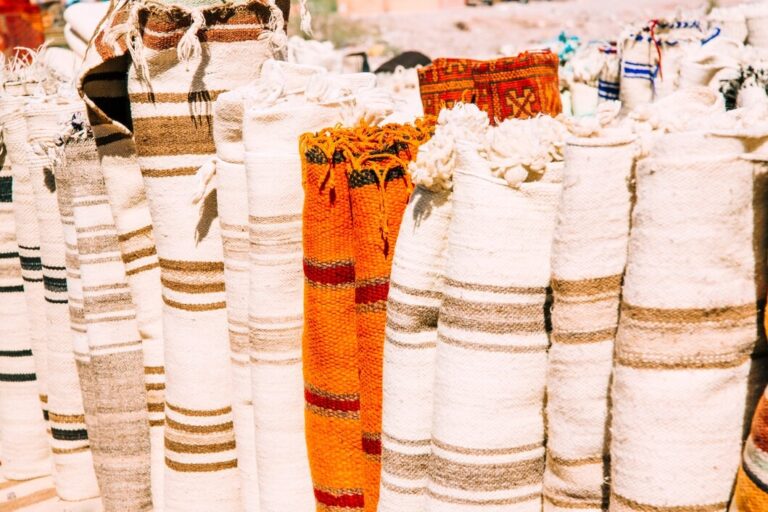Moroccan Berber carpets are more than just decorative objects; they embody a rich artisan tradition passed down from generation to generation. Each carpet tells a story, reflecting the cultural identity of the Berber tribes and their deep connection with nature and their environment.
Origins and cultural significance
Carpet weaving in Morocco dates back thousands of years, with the first traces dating back to the Paleolithic era. Berber women, guardians of this know-how, create unique pieces that serve as both protection against the cold and artistic expression.
The geometric patterns and symbols on the rugs are often stylized representations of nature, spiritual beliefs, or everyday events. These designs vary by region and tribe, with each community developing its own visual language.
Weaving techniques and materials used
Berber rugs are traditionally hand-woven from sheep’s wool, which is known for its durability and warmth. Natural dyes, extracted from plants, minerals and sometimes insects, offer a color palette ranging from neutral tones to vibrant hues.
Weaving techniques also vary: some rugs have a thick, fluffy texture, while others, like kilims, are flat and lightweight.

Varieties of Berber carpets
Morocco is home to a diversity of rug styles, each associated with a specific region:
Beni Ouarain
Originating from the Middle Atlas, these rugs are distinguished by their black geometric patterns on a creamy white background, bringing a touch of minimalist elegance.
Azilal
Originating from the High Atlas Mountains, they are known for their colorful, abstract patterns, often woven on a light background.
Boucherouite
Made from recycled fabric scraps, these multi-colored rugs reflect the creativity and ingenuity of the weavers.
Kilim
Flat-woven, these lightweight rugs feature intricate geometric designs and are often used as wall hangings or blankets.
Lorem ipsum dolor sit amet, consectetur adipiscing elit. Ut elit tellus, luctus nec ullamcorper mattis, pulvinar dapibus leo.
Building Business Partnerships Through Moroccan Cultural Events
In today’s interconnected world, businesses are constantly searching for innovative ways to establish trust, strengthen networks, and expand their reach....
Hiking Trails in the Middle Atlas Mountains
The Middle Atlas Mountains are often overshadowed by the High Atlas or the Rif, yet they hold some of Morocco’s...
From Passion to Profession: Turning Creative Skills into Income
In Morocco, more young people are transforming their creative talents into careers. Whether it’s photography, calligraphy, fashion design, or digital...
Young Moroccans Abroad: Balancing Wanderlust and Roots
For many young Moroccans, the dream of exploring the world is irresistible. Whether through study, work, or travel, living abroad...
Crafts at the heart of the local economy
Carpet making is a vital source of income for many Berber families. Women’s cooperatives play a crucial role in preserving these traditions while providing economic opportunities for female artisans. By purchasing an authentic Berber carpet, you are not only supporting traditional craftsmanship, but also the sustainable development of local communities.
The global influence of Berber carpets
Beyond the Moroccan borders, Berber rugs have conquered the world of interior design. Their timeless aesthetic and authenticity seduce designers and crafts lovers. Integrating a Berber rug into your interior means inviting a piece of history and culture, bringing warmth and character to any space.
Tips for buying a Berber carpet
To acquire an authentic carpet, it is recommended to:
Check authenticity : Favor handmade rugs, recognizable by their irregularities and uniqueness.
Learn about the origin : Know the region of origin and the type of rug to understand its cultural significance.
Consider materials : Opt for rugs made from natural wool and vegetable dyes for superior quality and increased durability.
In conclusion
Moroccan Berber rugs are much more than decorative objects; they are a reflection of a rich and vibrant culture. Each rug is a unique work of art, woven with passion and know-how, testifying to the history and traditions of the Berber people.
















Discussion about this post